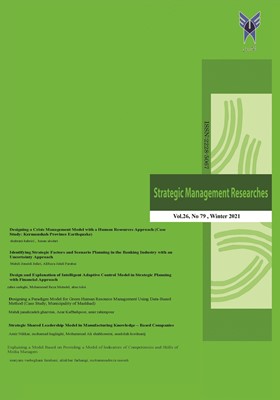Designing a Crisis Management Model with a Human Resources Approach (Case Study: Kermanshah Province Earthquake)
Subject Areas : Strategic Management Researchesshahram kahrizi 1 , HASAN alodari 2 *
1 - PhD Student, Human Resources Management, Payame Noor University, Tehran, Iran
2 - PhD in Organizational Behavior Management, Payame Noor University, Tehran, Iran
Keywords: Earthquake, crisis management, Theme Analysis, Human Resources Approach,
Abstract :
What turns an earthquake into a devastating catastrophe is the confrontation of human phenomena and anthropogenic factors with this natural phenomenon. One of the most important factors that increase or decrease the amount of damage and human casualties in the event of natural disasters, including earthquakes, is crisis management. The purpose of this study is to design a crisis management model with emphasis on human resources in Kermanshah earthquake. The method of this research is a qualitative approach with theme analysis. The statistical population of this study was all the literature in the field of crisis management models with a focus on human resources. The sample of this study included 11 related theories in the field of crisis management models based on focus on human resources. Library method was used to collect research data. Data analysis of this study was performed using Nvivo software. The results showed that the crisis management model with the human resources approach can be examined in three main stages: pre-crisis measures, crisis measures and post-crisis measures. Pre-crisis measures included themes to strengthen human resource efficiency, preventive measures, human resource training, and identification of early signs. Crisis measures included human resource preparedness. Post-crisis measures also included themes, identification and evaluation, limiting losses, and the ability to rebuild
احمد فصیح، صدیقه، ناخدا، مریم، اسماعیلی گیوی، محمدرضا و باب الحوائجی، فهیمه (1396). طراحی مدل پارادایمی مدیریت بحران و ارائه راهکارهای پیشگیری: بررسی سازمانهای اسنادی (آرشیوی) کشور. مجله مدیریت اطلاعات، 3(4)، 180-163.
احمدی، سید علی اکبر، رسولی، رضا، رجب زاده قطری، علی و پویای قلی زاده، پریسا (1391). ارائهی مدل مدیریت بحران با تمرکز بر نظام مدیریت منابع انسانی برای بیمارستانهای شهر تهران. فلصنامه مدیریت دولتی، 4(10)، 24-1.
اسدی، سعیده (1390). مدیریت بحران و تامین منابع برای بافتهای تاریخی پس از سانحه مورد مطالعاتی: ارگ بم. اولین کنفرانس بین المللی ساخت و ساز شهری در مجاورت گسل های فعال، شهرداری تبریز.
پرهیزگار، محمد مهدی و رحمانی، نیما (1392). شناسایی و اولویتبندی اقدامات کارآمد مدیریت منابع انسانی در شرایط بحران با استفاده از رویکرد ترکیبی ANP DEMATE پژوهش های مدیریت منابع سازمانی. ۳ (۳) :۱-۲۲
خلیلی، رضا، محمودزاده، امیر، غازی، ایران و رشیدی، محمد مهدی (1398). مدل مدیریت بحران در نظام منابع انسانی بنگاه های نفتی. فصلنامه علمی پژوهشی مدیریت منابع انسانی در صنعت نفت، 11(41)، 225-241.
خمر، غلامعلی و رخشانی، امین (1394). نقش راهکارهای مدیریت بحران در جهت کاهش خسارت ناشی از زلزله، مطالعه موردی: شهر خرم آباد. مجله جغرافیا و توسعه، 13(41)، 160-147.
ملکی، امجد،(1390). پهنه بندی خطر زمین لرزه واولویتبندی بهسازی مساکن دراستان کرمانشاه، همایش علمی سالانه دانشگاه رازی،کرمانشاه.
Aviso, K. B., Mayol, A. P., Promentilla, M. A. B., Santos, J. R., Tan, R. R., Ubando, A. T & Yu, K. D. S (2018). Allocating human resources in organizations operating under crisis conditions: A fuzzy input-output optimization modeling framework. Resources, Conservation and Recycling, 128, 250-258
Demirer, G.N(2015). Water recycling and reuse in soft drink/beverageindustry: a case study for sustainable industrial water management in Turkey.Resour. Conserv. Recycl. 104, 172–180.
Hetu, S. N., Gupta, S., Vu, V. A & Tan, G (2018). A simulation framework for crisis management: Design and use. Simulation Modelling Practice and Theory, 85, 15-32
Davis, Ian (2006)Learning from Disaster Recovery Guidance for Decision Makers”, International RecoveryPlatform(IRP):http://www.undp.org/bcpr/iasc/content/docs/Learning_from_Disaster_Recovery_Exec_Summary_May2006.pdf
Millson, A (2017). Provide model and crisis management plan for emergency situations. Resources, Conservation and Recycling, 128 (2):1-10
Myer, R. A., Conte, C & Peterson, S. E (2007). Human impact issues for crisis management in organizations. Disaster Prevention and Management: An International Journal, 16(5), 761-770.
Morgenson, M (2016). The post-earthquake housing recovery in Mexico City and Los Angeles and how to plan for institutions to deal with crisis recovery with reliance on human resources. Crisis Management, 2 (3): 16-1.
Naved Khan, M & Allil, K (2010). Determinants of mobile advertising adoption: A cross-country comparison of india and syria. IJMM, 5(1).
oombs, W. T & Laufer, D (2018). Global Crisis Management–Current Research and Future Directions. Journal of International Management, 24(3), 199-203
Paraskevas, A & Quek, M (2019). When Castro seized the Hilton: Risk and crisis management lessons from the past. Tourism Management, 70, 419-429.
Swainson, M (2019).Nonconformity, recall and crisis management. Swainson 's Handbook of Technical and Quality Management for the Food Manufacturing Sector, 267-290
SanjibChowdhury,EricSchulz,MorganMilner,DavidVanDeVoort,(2014).Coreemployeebased human capital and revenue productivity in small firms: An empirical investigation, Journal of Business Research, Volume 67, Issue 11, , Pages 2473-2479
_||_

